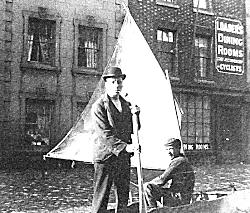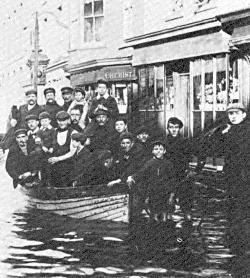
Flooding has been a feature of life at Point for centuries but according to a "History of Portsmouth" by Henry and Julian Slight (1828) the construction of New Gunwharf made matters significantly worse
"By the erection of the New Gunwharf over a part of the ancient Camber, the current of the tide has been materially altered. The shore at the end of Broad Street, is lower by many feet than it was a few years since, and the landing place is so deteriorated, that some remedial means must ere long be resorted to."

In 1830, Mr. Joseph Knott, the owner of the Union Tavern, at a vestry meeting held at St. Thomas' Church, said that the Parish should be compelled to repair the embankment at Point to prevent the sea making inroads into the beach to the danger of his property. The building of the New Gun Wharf had caused a change in the current which now was continually washing away the beach, and boats could no longer land there below half tide. It was also suggested that the Board of Ordnance, being responsible, should build a sea wall by using convict labour.
This part of Portsmouth was very much at the mercy of the gales and sea, and the newspapers frequently reported on the effects of high tide and storms:
"On Sunday last, about one o'clock, during the hard gale, an old chimney of a house situated in Point Street, belonging to Andrew Lindegren, Esq., suddenly fell and broke into the roof of the adjoining wash house. Fortunately a gentleman who was standing near, perceived it falling and thus happily escaped."
"We were again visited this day by an unusual high tide the water was high enough in Point Street to admit wherries as far up the street as the "Blue Posts", and Grand Parade was covered with water, which issued from the sinks and from the Sally Port, its height attended by so turbulent motion, was never before witnessed."
In 1840 it was reported that the tide was at least an inch and a half higher than it had been for 38 years. This had been recorded by an inhabitant of the Point who had made notches on his door post. The water had reached Grand Parade as there was the following announcement in the same newspaper:
"Grand Parade Inundation. London House, 76, High Street, Portsmouth. C. Coles, jun., begs to inform his Friends and the public in general, that in consequence of the Tide filling his warehouse with water, all Damaged and Soiled Goods will be CLEARED OFF at a great sacrifice."
The problems with wind and tide continued into the 20th century with the flooding of the area sometimes accompanied by considerable damage to property, especially the Floating Bridge yard and offices. In 1913 there was probably the worst storm for 50 years which wrecked the Victoria Pier and badly damaged the Sally Port:
"Victoria Pier is almost a wreck, large portions of the decking had been forced up, the landing stage at the pier head carried right away, and the pierhead structure, with its iron girders, at the entrance to the Pier proper, were completely demolished. The Sally Port ..... is no more, that is as far as the wooden platform and steps is concerned. In Broad Street the water was in parts from three to four feet high."

The inhabitants of Point were used to the regular inundation and were generally prepared for it. All houses in the danger area had slots at each side of their outside doors, into which wooden boards could be fitted. In addition they all possessed a bucket of clay with which to seal the gaps in the boards to make them watertight. There was a tale of one lady who stood at her front door behind the boards amused by the problems of her neighbours; on stepping back into water she discovered she had forgotten to fit the boards at the back door. Another precaution was to possess a Tide Table, and it was important to know how to interpret it. The danger signal was a Spring tide over 14 feet, with the wind blowing strongly into the Harbour entrance.
Cynthia Sherwood recalls that "...it was fascinating watching people coming out of the public house (the Union Tavern), and being confronted by this sudden expanse of sea. They (were faced with the options of being) rescued by boat or carried on the back of a strong man wearing waders. Although these floods often caused considerable damage to furniture and carpets the local inhabitants seemed to be surprisingly cheerful; there was much laughing and joking, even though it was going to be hard work drying out their houses. They were quite philsophical about it; it was just a hazard of living there and they had been brought up to expect these happenings for generations."

Towards the end of the 20th century the City Council decided that the regular flooding of Broad Street could no longer be tolerated. This was not only a response to the threat of global warming but a recognition that Point was becoming increasingly gentrified with modern residential accommodation lining Broad Street. It therefore installed a new range of flood gates at each of the vulnerable access points. It remains to be seen whether this will prove adequate in the face of a changing climate.
Adapted from research carried out by Cynthia Sherwood